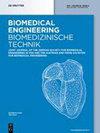同时验证可穿戴运动捕捉系统下半身应用:在单一平面运动范围(ROM)和步态活动
IF 1.8
4区 医学
Q4 ENGINEERING, BIOMEDICAL
引用次数: 5
摘要
在生物力学应用中,从{Zhu, 2019 #5}日常生活活动中提取数据对于为基于预期用途的应用定义精确的边界条件非常重要。尽管基于光电相机标记的系统被用作医疗应用的黄金标准工具,但由于视线问题,需要可穿戴,价格合理的运动捕捉(MOCAP)系统。我们研究了一种基于可穿戴惯性测量单元(IMU)的可穿戴MOCAP系统在生物力学应用中的潜在用途。通过电机控制的单平面解剖运动范围(ROM)模拟,同时通过光电标记和IMU传感器收集数据,为包括髋关节、膝关节和踝关节在内的整个下半身提供了体外概念验证。对15名健康志愿者进行两种系统的屈伸、外展、髋关节内外旋(ROM)值以及膝关节和踝关节的屈伸ROM值的计算。布兰德-奥特曼图在体外和体内实验中都显示出令人满意的一致性。两个系统在体外对髋关节屈曲运动的最大均方根误差(RMSE)分别为3.4°和5.9°。研究人员对志愿者的步态数据进行了评估,以调查一致性的限度,并计算了两种系统在步态周期内的总体平均值和标准差。踝关节<6°时差异最大。结果表明,所提出的制度可以作为一种负担得起的民主解决方案。本文章由计算机程序翻译,如有差异,请以英文原文为准。
Simultaneous validation of wearable motion capture system for lower body applications: over single plane range of motion (ROM) and gait activities
Abstract Extracting data from {Zhu, 2019 #5} daily life activities is important in biomechanical applications to define exact boundary conditions for the intended use-based applications. Although optoelectronic camera-marker based systems are used as gold standard tools for medical applications, due to line-of-sight problem, there is a need for wearable, affordable motion capture (MOCAP) systems. We investigate the potential use of a wearable inertial measurement unit (IMU) based-wearable MOCAP system for biomechanical applications. The in vitro proof of concept is provided for the full lower body consisting of hip, knee, and ankle joints via controlled single-plane anatomical range of motion (ROM) simulations using an electrical motor, while collecting data simultaneously via opto-electronic markers and IMU sensors. On 15 healthy volunteers the flexion-extension, abduction-adduction, internal-external rotation (ROM) values of hip and, the flexion – extension ROM values of the knee and ankle joints are calculated for both systems. The Bland-Altman graphs showed promising agreement both for in vitro and in vivo experiments. The maximum Root Mean Square Errors (RMSE) between the systems in vitro was 3.4° for hip and 5.9° for knee flexion motion in vivo, respectively. The gait data of the volunteers were assessed between the heel strike and toe off events to investigate the limits of agreement, calculating the population averages and standard deviation for both systems over the gait cycle. The maximum difference was for the ankle joint <6°. The results show that proposed system could be an option as an affordable-democratic solution.
求助全文
通过发布文献求助,成功后即可免费获取论文全文。
去求助
来源期刊
CiteScore
3.50
自引率
5.90%
发文量
58
审稿时长
2-3 weeks
期刊介绍:
Biomedical Engineering / Biomedizinische Technik (BMT) is a high-quality forum for the exchange of knowledge in the fields of biomedical engineering, medical information technology and biotechnology/bioengineering. As an established journal with a tradition of more than 60 years, BMT addresses engineers, natural scientists, and clinicians working in research, industry, or clinical practice.

 求助内容:
求助内容: 应助结果提醒方式:
应助结果提醒方式:


